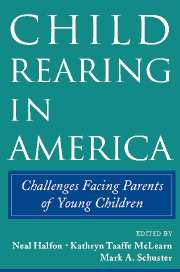Book contents
- Frontmatter
- Contents
- Tables
- Figures
- Contributors
- Acknowledgments
- 1 Introduction and Overview
- PART I CONDITIONS OF FAMILIES WITH YOUNG CHILDREN
- PART II CHILD-REARING PRACTICES
- 4 Meeting the Challenges of New Parenthood: Responsibilities, Advice, and Perceptions
- 5 Reading, Rhymes, and Routines: American Parents and Their Young Children
- 6 Child Discipline in the First Three Years of Life
- 7 Breastfeeding in the United States Today: Are Families Prepared?
- 8 Depressive Symptoms in Parents of Children Under Age 3: Sociodemographic Predictors, Current Correlates, and Associated Parenting Behaviors
- PART III DELIVERY OF HEALTH SERVICES TO MOTHERS AND CHILDREN
- PART IV FUTURE DIRECTIONS AND POLICY IMPLICATIONS
- Index
- References
5 - Reading, Rhymes, and Routines: American Parents and Their Young Children
Published online by Cambridge University Press: 15 July 2009
- Frontmatter
- Contents
- Tables
- Figures
- Contributors
- Acknowledgments
- 1 Introduction and Overview
- PART I CONDITIONS OF FAMILIES WITH YOUNG CHILDREN
- PART II CHILD-REARING PRACTICES
- 4 Meeting the Challenges of New Parenthood: Responsibilities, Advice, and Perceptions
- 5 Reading, Rhymes, and Routines: American Parents and Their Young Children
- 6 Child Discipline in the First Three Years of Life
- 7 Breastfeeding in the United States Today: Are Families Prepared?
- 8 Depressive Symptoms in Parents of Children Under Age 3: Sociodemographic Predictors, Current Correlates, and Associated Parenting Behaviors
- PART III DELIVERY OF HEALTH SERVICES TO MOTHERS AND CHILDREN
- PART IV FUTURE DIRECTIONS AND POLICY IMPLICATIONS
- Index
- References
Summary
The past few years have witnessed a renewed interest in early child development. The Carnegie Corporation's Starting Points (1994) and Years of Promise (1996) reports, the creation of a National Goals Panel and the Goals 2000 legislation of 1994, and President Clinton's early childhood initiative (1997) all provide evidence of increasing awareness of the importance of early experiences. Two White House conferences have focused on early childhood development and on child care. Media attention–including an entire issue of Newsweek devoted to the early years, a prime-time television documentary on early development, and numerous television news shows, newspaper articles, and magazine pieces–have conveyed the message that what happens in children's early years is strongly associated with their school readiness, achievement, and adolescent functioning.
During the early years, children make great strides in emotional regulation and the acquisition of gross motor, fine motor, language, cognitive, and social skills. Parents and committed caregivers are the primary providers of experiences associated with those developments. For example, parents provide cognitive and linguistic experiences through activities such as looking at books, encouraging communication, and exposing children to a range of auditory and visual stimuli Bradley (1995; Snow 1993). When parents exhibit warmth through actions such as hugging and cuddling, they influence their children's development of relationships and emotional well-being Barnard and Martell (1995). Finally, through regularity and consistency in daily routines, parents provide continuity and stability, conditions thought to be important to children Boyce et al. (1983).
- Type
- Chapter
- Information
- Child Rearing in AmericaChallenges Facing Parents with Young Children, pp. 117 - 145Publisher: Cambridge University PressPrint publication year: 2002
References
- 19
- Cited by



